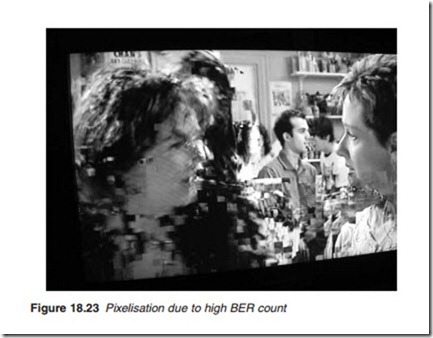Testing the digital TV decoder box
The first step in attempting to service a suspect DTV system is to determine whether the fault lies within the STB or outside it. The external factors that affect the video display and its quality may be divided into two categories: those that precede the STB (pre-STB), such as aerial or dish alignment, aerial lead and signal strength, and those that succeed it (post-STB), such as the HDMI or SCART connector and lead or the television set itself. Failures caused by the first category may be total video/audio failure, video and/or sound break-up, a symptom peculiar to digital TV reception. Failures in the second category do not include this type of video/audio break-up.
Aerials and dishes
In the conventional analogue system, low signal strength or low carrier-to- noise ratio (C/N) results in adverse picture quality, with ghosting in the case of terrestrial TV or noisy picture sparklies in the case of satellite TV. In digital TV reception, such conditions would cause the picture and sound to fail altogether. Low signal strength would result in failure of the channel decoder to lock to a channel, with a message ‘no signal’ being dis- played. In DTV, the picture is either perfect or non-existent. This is known as the digital cliff.
Unlike conventional analogue reception, where low signal strength or low C/N would result in low signal amplitude, in DTV applications it would result in increased bit error rate (BER). If the BER is too high, the FEC unit cannot correct the errors and the data would be marked accord- ingly. Normally, the video decoder decodes the video PES packets and stores them in the video memory for display. The video memory would thus be updated as new PES packets are decoded. However, when a PES is marked as erroneous, it is neglected and the relevant part of the video memory fails to update; this produces a freeze in that part of the picture and pixelisation results as illustrated in Figure 18.23. If a whole series of PES packets are marked erroneous, none of the video memory is updated and a picture freeze occurs. This latter effect may be observed immedi- ately after removing the aerial lead. In this case, the freeze continues for a few moments before the picture disappears completely. Where audio PES packets are marked erroneous, they are neglected by the audio decoder and sound break-up results.
A spectrum analyser may measure the strength of the signal from an antenna. The software resident within the STB provides a facility for meas- uring the signal strength which may be used as an indication of the signal strength but not as an accurate measurement. Low signal strength may be
caused by aerial misalignment, low antenna gain or adverse reception conditions.
In terrestrial DTV reception, picture and/or sound break-up may also result from strong reflected waves with long delays. COFDM is designed to avoid the effects of reflected waves provided they arrive at the aerial before the end of the guard period. The actual time delay that may be accommodated will depend on the COFDM mode as well as the selected guard period. For a 2K mode and a guard period of one-quarter, the sym- bol duration—the maximum delay that could be accommodated is 56 J.s. Reflected waves with longer delays are normally too weak to have any effect on the decoding process. However, where high-gain aerials or RF amplifiers are used, these reflected waves with long time delays may be strong enough to introduce uncertainty in the FEC processor, resulting in intermittent video and/or sound break-up. To avoid this, plug-in attenuators may be fitted to the aerial input socket of the STB.
The aerial cable carries signals with frequencies in the UHF or higher bands. Cable attenuation and the physical condition of the lead thus become important factors in signal integrity. This explains why low impedance double-screened coaxial cables are normally used. Bends and kinks in the cable may disturb the standing wave along the cable, causing intermittent video and/or sound break-up. Similar effects may be produced if the cable is squeezed by a very tight clip, for instance.
For satellite reception, the size of the dish, the condition of the F-connectors and the condition of the LNB will have an effect on the signal strength and hence the quality of the video reproduction.
